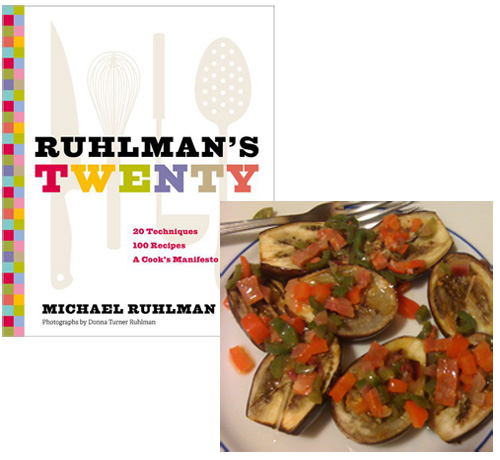Ruhlman’s Twenty: Chorizo Vinaigrette

I’d had my eye on Ruhlman’s Twenty, a new cookbook from Michael Ruhlman, for most of the fall, especially after seeing a post at Erin Rooney Doland’s Unclutterer about Ruhlman’s championing of organizing principles in the kitchen, better known as mise en place. “Cooking is easier, faster, more efficient, more successful, and more fun when you think first, when you prepare and organize,” Doland quoted Ruhlman:
“This is not an additional step—it’s simply doing all that you would do throughout the cooking anyway. You’re just doing it ahead of time, spending less time between cupboard and counter, refrigerator and stove. Be sure your counter or work area is completely clear. Go to the refrigerator, pull everything you’re going to need, and set it out. Go to the cupboard, and pull everything there you’ll need. Gather your tools beside your cutting board, set the pans you’ll need on the stove, and get the oven hot if you’re using it. Think about the sequence of your actions. And then being to work, and as you work while you’re doing one thing, think about what you’ll be doing next and next after that.”
This is excellent advice for cooking, but of course it’s also excellent advice for any creative endeavor, and it’s something that I’m working on incorporating more fully into my life as I undertake some major new projects in the months ahead, which you’ll be hearing about as they become ready to reveal. There’s a second, equally important component to mise en place, though: “Put away everything that you don’t need.” It’s something that I’ve struggled with in the past, hanging on to books long past the time when it’s become obvious I won’t be reviewing them any time soon; moving into a new apartment a little over a year ago gave me an opportunity to purge, but I’m still working on dealing with the creeping piles, and I’m hoping to improve a lot in this aspect of my creative life, too.
Anyway, Ruhlman’s Twenty: I love that these are all very simple recipes, grounded in teaching me fundamental techniques that I’ll be able to experiment with at my own pace. The chapter on vinaigrette is a perfect example: I’m one of those people Ruhlman talks about, who never thought about vinaigrette beyond salad dressing, so the idea that it can serve as the base as a sauce to go with all sorts of cooked dishes was a real revelation. So the first recipe I decided to make from the book was a chorizo vinaigrette that calls for equal proportions of diced chorizo, red onion, red bell pepper, and jalapeno, sauteed in canola oil (although I used olive oil) with a generous helping of salt, then tossed in sherry vinegar once it’s cooled. I had no luck finding sherry vinegar in the grocery stores in my Queens neighbhorhood, but I did have a bottle of apple cider vinegar, and that substitution seems to have worked just fine.
The first time I made the vinaigrette, we just put it over a basic salad, and it was really good—the jalapeno and chorizo give it a little kick, but it’s certainly not overwhelming. Then, a few days later, I made myself another batch, which I spread out over a plate of tiny roast eggplants. Let me tell you, that was fantastic. I’ve tried roasting eggplant off and on, and it’s never really caught on for me, because I’d never found the right way to boost the basic taste. (I know, I could just put sriracha on it, because sriracha solves taste problem, but let’s say I wanted a second solution.) The peppers and onion and tiny bits of sausage were fantastic over the texture of the eggplant; of course, you could easily do this vinaigrette without the chorizo if you’re a vegetarian. Now I’m a vinaigrette convert, thanks to Ruhlman; I can definitely see adding them to the majority of our cooked meals, and I can’t wait to try his leeks vinaigrette the next time my wife cooks fish.
I’ve been flipping through the other chapters, too; there’s a lot of technique in Ruhlman’s Twenty I want to get under my belt, so that I can make the transition from a guy who can do a couple of dishes reasonably well to a genuinely improvisational cook.
4 January 2012 | books for creatives, cooking |

 Our Endless and Proper Work is my new book with Belt Publishing about starting (and sticking to) a productive writing practice.
Our Endless and Proper Work is my new book with Belt Publishing about starting (and sticking to) a productive writing practice. 
